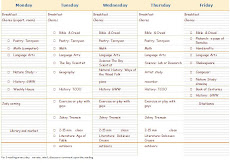 I found this neat post Wrestling with Homer at a blog I hadn't seen before, Fanning the Flames.
I found this neat post Wrestling with Homer at a blog I hadn't seen before, Fanning the Flames.I am sitting here with a pile of books:
Classical Writing Aesop, Homer and Diogenes
PLUS Connecting with History (a Catholic resource somewhat similar to Tapestry of Grace, designed by two internet friends of mine from way back)
Oh, yes, and Composition in the Classical Tradition.
I think I've mentioned before that I have a lot of trouble using any "teacher" resources. The basic rule of thumb is: If I can't simply hand it to my kid, I can't use it. That is why I end up using workbooks and living books more than almost anything. My preferred approach to education is the tutoring model -- the kid works with the material, and I help him by (sometimes) introducing the lesson and (sometimes) helping him solve difficulties and (sometimes) correcting or helping him go over his independent work. Books and workbooks lend themselves to this, while teacher-intensive resources generally don't.
These resources are so good, however, that I would like to make them work....somehow... so that is why I am sitting here with this pile. They are teacher resources, yet the methods are high-quality and so are the related philosophy and resources.
We are not studying ancient history this year, so I didn't dig out Connecting with History because of the material. Rather, I saw it with the other resources : ) plus I wanted to revisit their method, summarized here. It is somewhat inspired by the Ignatian method, which I talked about here.
Classical Writing advocates a "routine" for Analysis and Imitation. I wrote a bit about that here.
From Classical Writing: Models
It seems to me, firstly, that what a man seeks through his education is to get to know himself and the world; next, that for this knowledge it is before all things necessary that he acquaint himself with the best that has been thought and said in the world; finally, that of this (best), the classics of Greece and Rome form a very chief portion and the portion most entirely satisfactory.~ Matthew Arnold
Yesterday it occurred to me that I have been having trouble using resources like Classical Writing because I am focusing on the "teaching" part of the thing; when in actual fact, I have always had much more success focusing on a source or model, and then doing the teaching "by the way".
It's a bit difficult to explain, but the way the Ignatian educators approached literary models was to focus on the models themselves. They did it in two ways -- one was to use the literary model as an example of a precept. This was the "deductive" approach. Another was to focus on the model, and then use it as an example of a given precept of style. This was called the "inductive" approach.
This is the analysis component of the literary lesson. The "imitation" followed. It was almost an enactment of what had been learned. The lessons have often been compared to "practicums" -- putting knowledge into practice. But the point I am trying, not very well, to express, is that the model itself was the key thing. As Charlotte Mason puts it in a different context, the object is outside of ourselves.
I am not sure why, but I think that this is the source of my past difficulty using progym activities, though I am so in love with the idea. I think I was approaching it too much from the "improvement" side of things, and so I was bogged down in an internal contradiction.
So I'm approaching planning the progym from a different perspective, in light of that. I'll try to be clearer and more specific some other time. Right now I just wanted to write that out in order to see if I could ;-).



No comments:
Post a Comment